 Taj Mahal: This monument of love in sparkling white marble is the epitome of beauty and grandeur. The Taj Mahal was built in the 17th century by Mughal Emperor Shahjahan in memory of his beloved wife Mumtaz Mahal. Situated on the banks of sacred river Yamuna, the construction of Taj took 22 years. Beautiful gardens, gateway structures and mosques complete the entire Taj complex.
Taj Mahal: This monument of love in sparkling white marble is the epitome of beauty and grandeur. The Taj Mahal was built in the 17th century by Mughal Emperor Shahjahan in memory of his beloved wife Mumtaz Mahal. Situated on the banks of sacred river Yamuna, the construction of Taj took 22 years. Beautiful gardens, gateway structures and mosques complete the entire Taj complex.
 Agra Fort: Built by Emperor Akbar in the 16th century, the Agra Fort is another masterpiece of Mughal architecture dotting Agra's landscape. The Agra Fort is regarded as a great fusion of Islamic and Hindu styles of architecture. The entire monument has been built using red sandstone.
Agra Fort: Built by Emperor Akbar in the 16th century, the Agra Fort is another masterpiece of Mughal architecture dotting Agra's landscape. The Agra Fort is regarded as a great fusion of Islamic and Hindu styles of architecture. The entire monument has been built using red sandstone.
 Itmad-ud-Daulah's Tomb: Built in memory of her father by Mughal empress Noorjahan, the tomb of Itmad-ud-Daulah is also called the 'Baby Taj'. This mausoleum is known for its elaborate carvings and inlay work. The tomb contains cenotaphs of Empress Noorjahan's parents. This tomb is also built in white marble.
Itmad-ud-Daulah's Tomb: Built in memory of her father by Mughal empress Noorjahan, the tomb of Itmad-ud-Daulah is also called the 'Baby Taj'. This mausoleum is known for its elaborate carvings and inlay work. The tomb contains cenotaphs of Empress Noorjahan's parents. This tomb is also built in white marble.
 Fatehpur Sikri: Fatehpur Sikri, within close proximity to Agra, speaks of the architectural splendor of Mughal rule. The one thing that strikes tourists on entering Fatehpur Sikri are the magnificent buildings in red sand stone. Fatehpur Sikri was built by Mughal Emperor Akbar in the 16th century.
Fatehpur Sikri: Fatehpur Sikri, within close proximity to Agra, speaks of the architectural splendor of Mughal rule. The one thing that strikes tourists on entering Fatehpur Sikri are the magnificent buildings in red sand stone. Fatehpur Sikri was built by Mughal Emperor Akbar in the 16th century.


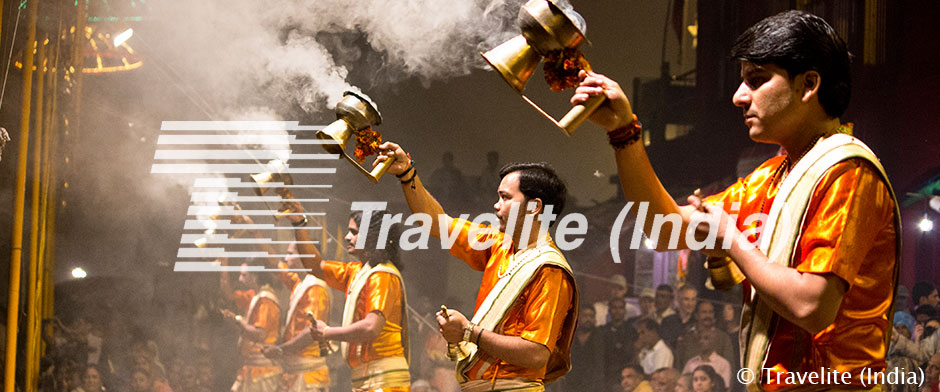
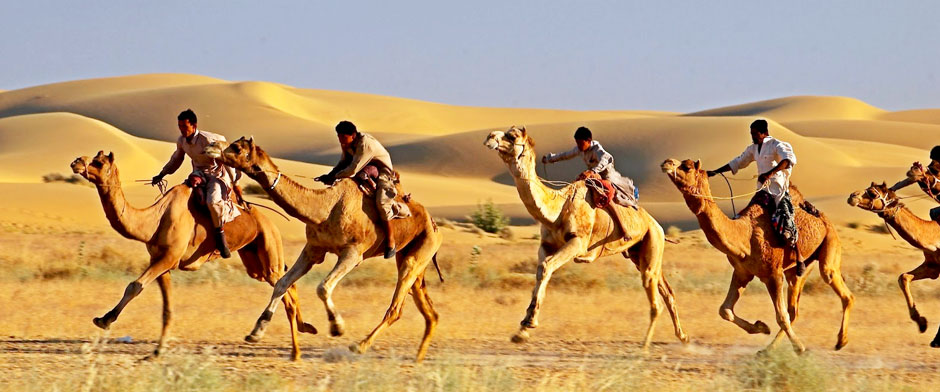
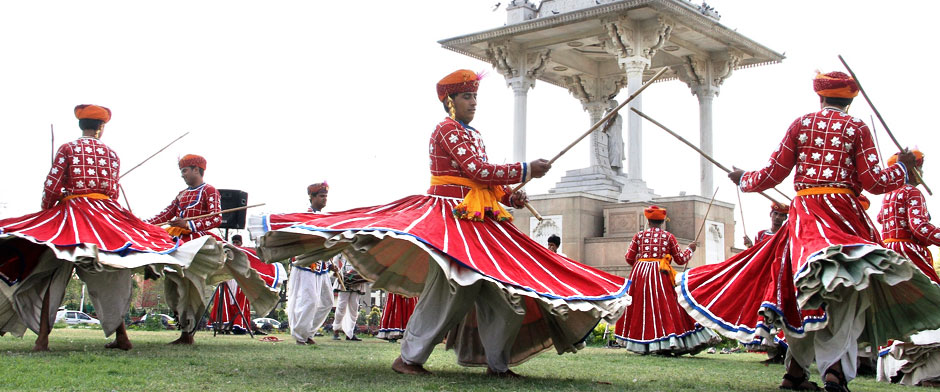
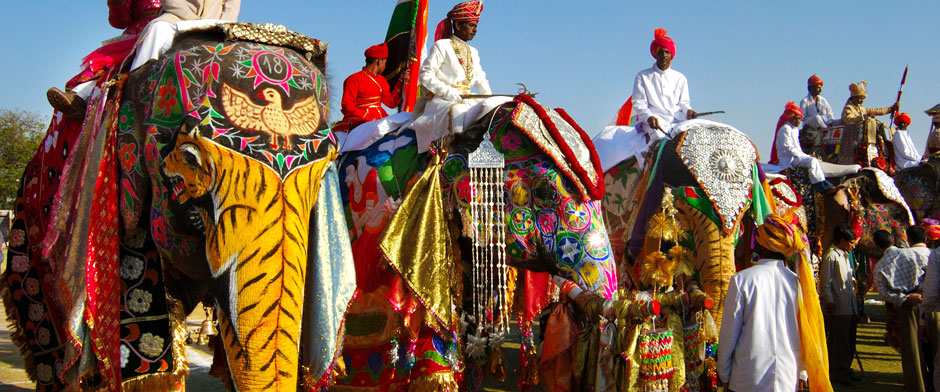

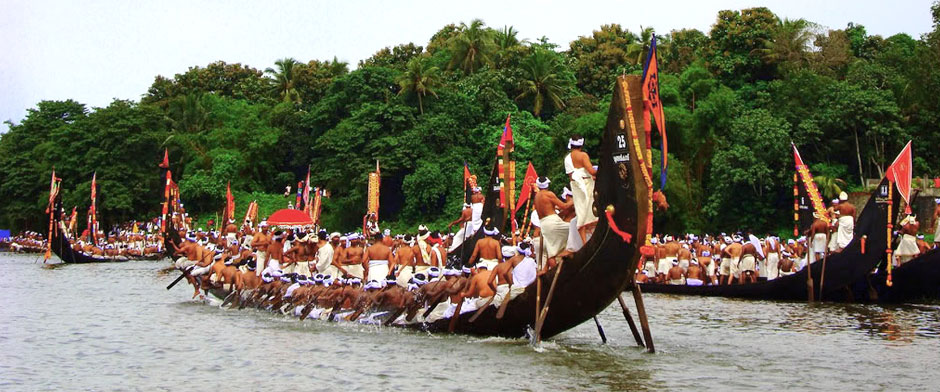
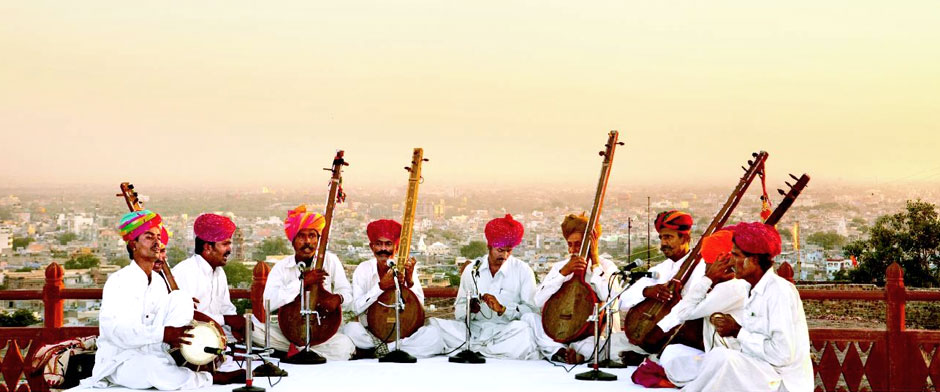
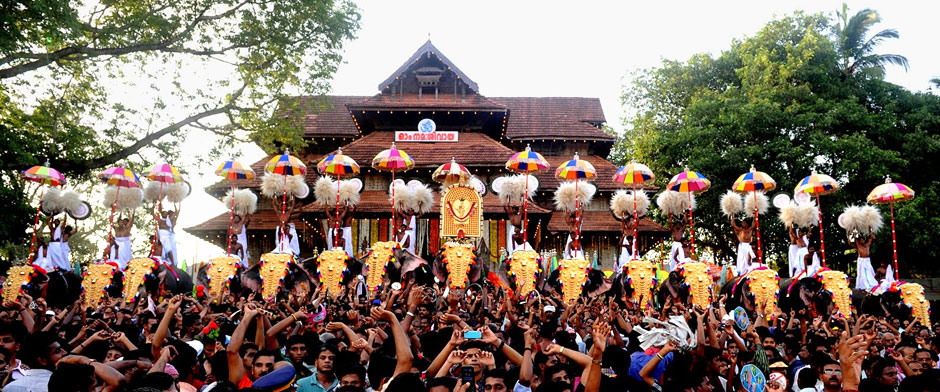

























































































 Ancient Indian wisdom has created the practical science of Yoga which provides mental peace, radiant health and spiritual fulfilment to soothe the stress of modern life. Kovalam is home to a large number of Ayurveda ashrams, clinics, resorts, centres and spas.
Ancient Indian wisdom has created the practical science of Yoga which provides mental peace, radiant health and spiritual fulfilment to soothe the stress of modern life. Kovalam is home to a large number of Ayurveda ashrams, clinics, resorts, centres and spas.









































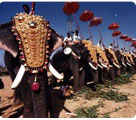 The Great Elephant March is celebrated with a large gathering of Indian tuskers touring around Kerala - all decked up and ready to be worshipped and pampered! Elephants are associated with the famous Hindu God with a trunk – Lord Ganesha, who is worshipped as the lord of wealth and fulfillment. Rather than being a religious occasion, the elephant march is a unique festive occasion, enjoyed by both locals and tourists in Kerala
The Great Elephant March is celebrated with a large gathering of Indian tuskers touring around Kerala - all decked up and ready to be worshipped and pampered! Elephants are associated with the famous Hindu God with a trunk – Lord Ganesha, who is worshipped as the lord of wealth and fulfillment. Rather than being a religious occasion, the elephant march is a unique festive occasion, enjoyed by both locals and tourists in Kerala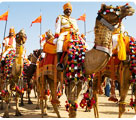 The Desert Festival of Jaisalmer, as the name suggests, is held in the deserts of Jaisalmer, in January (or February) every year. Celebrated with a number of cultural events, camel races, folk music and dance shows, turban tying competitions etc, the festival brings to life the traditions of the nomadic desert life of Jaisalmer. The rich culture of the region is on display during this three day long colourful extravaganza. The festival attracts a large number of foreign tourists, who are intrigued by the unusual customs of the region.
The Desert Festival of Jaisalmer, as the name suggests, is held in the deserts of Jaisalmer, in January (or February) every year. Celebrated with a number of cultural events, camel races, folk music and dance shows, turban tying competitions etc, the festival brings to life the traditions of the nomadic desert life of Jaisalmer. The rich culture of the region is on display during this three day long colourful extravaganza. The festival attracts a large number of foreign tourists, who are intrigued by the unusual customs of the region.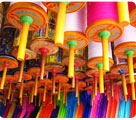 In India’s western state of Gujarat, the International Kite Festival is held in Ahmadabad on January 14, to coincide with the festival of Uttarayan or Makar Sankranti. It is a day when families and friends meet outdoors playing and competing against each other's kites. The people of Gujarat celebrate Uttarayan with a lot of enthusiasm and all business comes to a grinding halt for a couple of days. The festival lures expert kite-makers and fliers not only from major cities of India but also from around the world! A plethora of designer kites are also put on display. The festival is also a celebration to mark the end of winter.
In India’s western state of Gujarat, the International Kite Festival is held in Ahmadabad on January 14, to coincide with the festival of Uttarayan or Makar Sankranti. It is a day when families and friends meet outdoors playing and competing against each other's kites. The people of Gujarat celebrate Uttarayan with a lot of enthusiasm and all business comes to a grinding halt for a couple of days. The festival lures expert kite-makers and fliers not only from major cities of India but also from around the world! A plethora of designer kites are also put on display. The festival is also a celebration to mark the end of winter.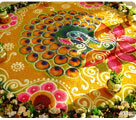 Pongal, a huge harvest festival in southern India, is India's equivalent of Thanksgiving and is celebrated with much enthusiasm. The festival is an important one because much of the state relies on agriculture to generate an income. The most important part of the festival is cooking the Pongal dish, made out of boiled milk and rice, on the auspicious second day. Families gather to feast and dance.
Pongal, a huge harvest festival in southern India, is India's equivalent of Thanksgiving and is celebrated with much enthusiasm. The festival is an important one because much of the state relies on agriculture to generate an income. The most important part of the festival is cooking the Pongal dish, made out of boiled milk and rice, on the auspicious second day. Families gather to feast and dance.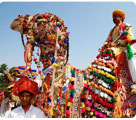 The Camel Festival is held in Bikaner in Rajasthan, every year in the month of December or January. It is a festival when the ships of the desert are seen at their best - camels fascinate tourists from all over the world!
The Bikaner camel festival is a spectacle of unusual camel performances including camel races, camel dances, and the bumpy, neck shaking camel rides. The festival starts with the procession of beautifully decorated camels, heading towards open sand grounds. The Camel Pageant is held on the first day where the camel owners show off their decorated camels. Competitions are held for best decorated camel, camel milking and the best camel hair cuts. Camel dance performances are also held, where camels display amazing footwork, dancing gracefully to the slightest direction of their drivers. Camel races also take place, with thousands of locals and tourists cheering the camels. The evenings end with a rendezvous with the folk music and dances of Rajasthan. The jubilant, skirt swirling dancers, the awe inspiring fire dances and many other equally interesting performances entertain the visitors. The grand finale is a magnificent display of fireworks, illuminating the desert city of Bikaner.
The Camel Festival is held in Bikaner in Rajasthan, every year in the month of December or January. It is a festival when the ships of the desert are seen at their best - camels fascinate tourists from all over the world!
The Bikaner camel festival is a spectacle of unusual camel performances including camel races, camel dances, and the bumpy, neck shaking camel rides. The festival starts with the procession of beautifully decorated camels, heading towards open sand grounds. The Camel Pageant is held on the first day where the camel owners show off their decorated camels. Competitions are held for best decorated camel, camel milking and the best camel hair cuts. Camel dance performances are also held, where camels display amazing footwork, dancing gracefully to the slightest direction of their drivers. Camel races also take place, with thousands of locals and tourists cheering the camels. The evenings end with a rendezvous with the folk music and dances of Rajasthan. The jubilant, skirt swirling dancers, the awe inspiring fire dances and many other equally interesting performances entertain the visitors. The grand finale is a magnificent display of fireworks, illuminating the desert city of Bikaner.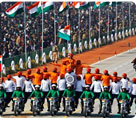 In celebration of the Constitution of India being founded in 1950, a spectacular Republic Day parade is held in New Delhi on 26 January every year. The parade, which marches down Delhi's central Rajpath Avenue, features the three divisions of the armed forces (Army, Navy and Air Force) who showcase their strength and stride. It also includes traditional dance troupes from various regions of India, and culminates with a dramatic aero show by helicopters and other aircraft.
In celebration of the Constitution of India being founded in 1950, a spectacular Republic Day parade is held in New Delhi on 26 January every year. The parade, which marches down Delhi's central Rajpath Avenue, features the three divisions of the armed forces (Army, Navy and Air Force) who showcase their strength and stride. It also includes traditional dance troupes from various regions of India, and culminates with a dramatic aero show by helicopters and other aircraft.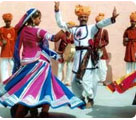 The picturesque town of Nagaur is home to the famous Nagaur Fair, Rajasthan’s second largest cattle fair held every year during the month of January or February.
The picturesque town of Nagaur is home to the famous Nagaur Fair, Rajasthan’s second largest cattle fair held every year during the month of January or February.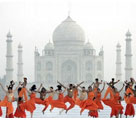 The Taj Mahotsav is a 10 day carnival held in the month of February every year, at Shilpgram, near the magnificent Taj Mahal, in Agra. The festival commences with a spectacular procession inspired by Mughal splendour, with elephants and camels, drum beaters, folk artists and master craftsmen recreating the glorious past of the Mughals. Taj Mahotsav offers a great opportunity for local artists to display their exquisite works of art and folk musicians and dancers to perform on stage for visitors. The festival is an intriguing journey into the customs and traditions and local lifestyle of the erstwhile Mughal era, enjoyed by locals and tourists alike.
The Taj Mahotsav is a 10 day carnival held in the month of February every year, at Shilpgram, near the magnificent Taj Mahal, in Agra. The festival commences with a spectacular procession inspired by Mughal splendour, with elephants and camels, drum beaters, folk artists and master craftsmen recreating the glorious past of the Mughals. Taj Mahotsav offers a great opportunity for local artists to display their exquisite works of art and folk musicians and dancers to perform on stage for visitors. The festival is an intriguing journey into the customs and traditions and local lifestyle of the erstwhile Mughal era, enjoyed by locals and tourists alike.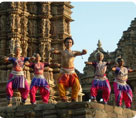 Khajuraho Dance Festival is held every spring in the town of Khajuraho, to celebrate the glory of the fascinating Khajuraho temples. This festival is a cultural extravaganza, celebrating Indian arts - dance and music learnt from generation to generation. The Khajuraho Dance Festival presents the best classical dances of India, performed by well reputed dance groups from around the country.
Khajuraho Dance Festival is held every spring in the town of Khajuraho, to celebrate the glory of the fascinating Khajuraho temples. This festival is a cultural extravaganza, celebrating Indian arts - dance and music learnt from generation to generation. The Khajuraho Dance Festival presents the best classical dances of India, performed by well reputed dance groups from around the country.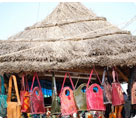 Into its 25th year this year, the Surajkund Crafts Mela showcases the finest handloom, handicrafts, and Indian cuisine. Surajkund becomes alive with the rhythm and beats of folk dances and riot of colors. Over 400 artisans display and demonstrate their crafts from all over India. There are also cultural programs, and an amusement zone for children.T he mela has a different theme every year.
Into its 25th year this year, the Surajkund Crafts Mela showcases the finest handloom, handicrafts, and Indian cuisine. Surajkund becomes alive with the rhythm and beats of folk dances and riot of colors. Over 400 artisans display and demonstrate their crafts from all over India. There are also cultural programs, and an amusement zone for children.T he mela has a different theme every year. Holi is commonly referred to as the "Festival of Colors". People exuberantly throw colored powder and water all over each other, have parties, and dance under water sprinklers. On the eve of Holi people light bonfires to mark the occasion and ward off evil spirits. Holi is a very carefree festival that's great fun to participate in if you don't mind getting wet and coloured!
Holi is commonly referred to as the "Festival of Colors". People exuberantly throw colored powder and water all over each other, have parties, and dance under water sprinklers. On the eve of Holi people light bonfires to mark the occasion and ward off evil spirits. Holi is a very carefree festival that's great fun to participate in if you don't mind getting wet and coloured!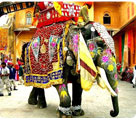 The Elephant Festival is a unique event held annually in Jaipur, the capital of Rajasthan. As the name suggests, the Elephant festival is in honour of the Indian tuskers. Groomed to perfection, glittering in gold, row upon row of elephants catwalk before an enthralled audience. Elephant races, elephant-polo matches and a most interesting tug of war between elephants and men, are all part of this spectacular event.
The Elephant Festival is a unique event held annually in Jaipur, the capital of Rajasthan. As the name suggests, the Elephant festival is in honour of the Indian tuskers. Groomed to perfection, glittering in gold, row upon row of elephants catwalk before an enthralled audience. Elephant races, elephant-polo matches and a most interesting tug of war between elephants and men, are all part of this spectacular event.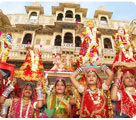 The Mewar Festival is celebrated to welcome the arrival of spring. The festival is celebrated in the romantic lake city of Udaipur and coincides with the Gangaur Festival. The highlight of the Mewar festival is a procession of Rajasthani women, dressed in colourful saris, carrying idols and images of goddess Gauri to the serene Lake Pichola. An unusual procession of boats on the lake, amidst loud chanting of folk Rajasthani ballads, offers an exhilarating finale to this splendid celebration. The festivities also feature cultural events where Rajasthani culture is portrayed through folk songs, dances, drama performances, and a colourful display of fireworks.
The Mewar Festival is celebrated to welcome the arrival of spring. The festival is celebrated in the romantic lake city of Udaipur and coincides with the Gangaur Festival. The highlight of the Mewar festival is a procession of Rajasthani women, dressed in colourful saris, carrying idols and images of goddess Gauri to the serene Lake Pichola. An unusual procession of boats on the lake, amidst loud chanting of folk Rajasthani ballads, offers an exhilarating finale to this splendid celebration. The festivities also feature cultural events where Rajasthani culture is portrayed through folk songs, dances, drama performances, and a colourful display of fireworks.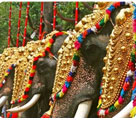 Thrissur Pooram is the biggest and most colorful temple festival of Kerala. It is celebrated in Vadakkumnathan temple in the Thrissur district. The festival is famous for its unique decorated elephant procession (Kudamattom), which involves participation of elephants from various temples across Kerala. Apart from this splendid procession, other attractions of Thrissur Pooram festival include a spectacular display of colorful fireworks, parasol exchanges, an umbrella showing competition, and drum concerts. Lasting for 36 hours, the festival draws the largest crowds in Kerala, fascinating locals and tourists in the region.
Thrissur Pooram is the biggest and most colorful temple festival of Kerala. It is celebrated in Vadakkumnathan temple in the Thrissur district. The festival is famous for its unique decorated elephant procession (Kudamattom), which involves participation of elephants from various temples across Kerala. Apart from this splendid procession, other attractions of Thrissur Pooram festival include a spectacular display of colorful fireworks, parasol exchanges, an umbrella showing competition, and drum concerts. Lasting for 36 hours, the festival draws the largest crowds in Kerala, fascinating locals and tourists in the region.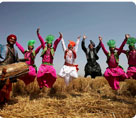 Baisakhi is a harvest festival, a Punjabi New year festival, and commemoration of the founding of the Khalsa….. all rolled into one occasion. Baisakhi is celebrated with a great deal of feasting, dancing, folk music, and fairs. A carnival atmosphere prevails in the area surrounding the Golden Temple in Amritsar.
Baisakhi is a harvest festival, a Punjabi New year festival, and commemoration of the founding of the Khalsa….. all rolled into one occasion. Baisakhi is celebrated with a great deal of feasting, dancing, folk music, and fairs. A carnival atmosphere prevails in the area surrounding the Golden Temple in Amritsar.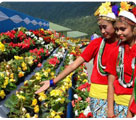 The International Flower Festival held annually in May, in Gangtok in the state of Sikkim, is one of the most popular flower shows of India. This festival features exotic varieties of local flowers, orchids and other plants of Sikkim. During this time, the state of Sikkim blooms with about 600 species of orchids, 240 species of trees and ferns, 150 varieties of gladioli, and 46 types of rhododendrons, along with a variety of magnolias and many other foliage plants. The flora displayed in the Gangtok Flower Festival mainly comprises of climbers, alpine plants, cacti, herbs orchids, creepers, gladioli, ferns, roses, etc.
The International Flower Festival held annually in May, in Gangtok in the state of Sikkim, is one of the most popular flower shows of India. This festival features exotic varieties of local flowers, orchids and other plants of Sikkim. During this time, the state of Sikkim blooms with about 600 species of orchids, 240 species of trees and ferns, 150 varieties of gladioli, and 46 types of rhododendrons, along with a variety of magnolias and many other foliage plants. The flora displayed in the Gangtok Flower Festival mainly comprises of climbers, alpine plants, cacti, herbs orchids, creepers, gladioli, ferns, roses, etc.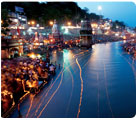 Ganga Dusshera is a holy festival, devoted to the worship of the Holy River Ganges. It is believed that the ‘Gangavataran’ (the descent of River Ganges) took place at this time. On this day, holy places along the Ganges plain such as Varanasi, Haridwar, Rishikesh, hold special significance. A large number of devotees flock to numerous ghats located along the banks of River Ganges to worship and wash away their sins in the holy water. At dawn and dusk, the banks of River Ganges are lit up with thousands of earthern lamps and candles with priests performing holy rituals and worshipping the River Goddess.
Ganga Dusshera is a holy festival, devoted to the worship of the Holy River Ganges. It is believed that the ‘Gangavataran’ (the descent of River Ganges) took place at this time. On this day, holy places along the Ganges plain such as Varanasi, Haridwar, Rishikesh, hold special significance. A large number of devotees flock to numerous ghats located along the banks of River Ganges to worship and wash away their sins in the holy water. At dawn and dusk, the banks of River Ganges are lit up with thousands of earthern lamps and candles with priests performing holy rituals and worshipping the River Goddess. 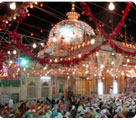 Held in the holy town of Ajmer in honour of the Sufi saint, Khwaja Moinuddin Chishti, Urs Fair is marked by special prayers offered at the mosque, and huge amounts of food offered from the large, steaming cauldrons that were a gift from Emperor Akbar. While quwallis are sung at night, the celebrations unite people of all faiths, and the complete town is decorated with buntings, and wears the spirit of festivity. It is an occasion for thousands of believers to congregate at the shrine and offer their prayers. All of Ajmer seems to take on a festive air and several programmes are organized to mark the festival.
Held in the holy town of Ajmer in honour of the Sufi saint, Khwaja Moinuddin Chishti, Urs Fair is marked by special prayers offered at the mosque, and huge amounts of food offered from the large, steaming cauldrons that were a gift from Emperor Akbar. While quwallis are sung at night, the celebrations unite people of all faiths, and the complete town is decorated with buntings, and wears the spirit of festivity. It is an occasion for thousands of believers to congregate at the shrine and offer their prayers. All of Ajmer seems to take on a festive air and several programmes are organized to mark the festival.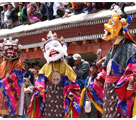 The Hemis Festival is held every year in the Hemis Monastery, the biggest Buddhist monastery of Ladakh. It is celebrated on the tenth day of lunar month in the Tibetan calendar. The festival is celebrated in the commemoration of the birth anniversary of Guru Padmasambhava. Hemis festival is celebrated with a colourful fair displaying some of the most exquisite handicrafts of Ladakh region and the display of the two-story high 'Thanka' of the monastery. The Thanka is beautifully embroidered with pearls and semi-precious stones, and depicts Guru Padmasambhava –it is put on display once in twelve years.
The Hemis Festival is held every year in the Hemis Monastery, the biggest Buddhist monastery of Ladakh. It is celebrated on the tenth day of lunar month in the Tibetan calendar. The festival is celebrated in the commemoration of the birth anniversary of Guru Padmasambhava. Hemis festival is celebrated with a colourful fair displaying some of the most exquisite handicrafts of Ladakh region and the display of the two-story high 'Thanka' of the monastery. The Thanka is beautifully embroidered with pearls and semi-precious stones, and depicts Guru Padmasambhava –it is put on display once in twelve years.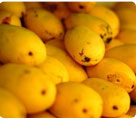 The Mango Festival is celebrated in India’s capital city, New Delhi, every year in the month of July. Held at Talkatora stadium, it is one of the most awaited fairs in the capital city. The festival also marks the advent of mangoes and presents more than 500 varieties of this king of fruits. Mangoes from different states of the country, are brought under one roof, where visitors can taste the summer fruit and learn more about each variety. Given the exotic seasonality of mangoes, the festival is a tasteful delight for locals and tourists visiting the capital region.
The Mango Festival is celebrated in India’s capital city, New Delhi, every year in the month of July. Held at Talkatora stadium, it is one of the most awaited fairs in the capital city. The festival also marks the advent of mangoes and presents more than 500 varieties of this king of fruits. Mangoes from different states of the country, are brought under one roof, where visitors can taste the summer fruit and learn more about each variety. Given the exotic seasonality of mangoes, the festival is a tasteful delight for locals and tourists visiting the capital region.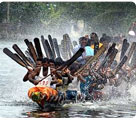 Nehru Trophy Boat Race (also referred as ‘snake boat race’) is an annual event organized in Alappuzha, Kerala. It is held every year on the second Saturday of August. The event is promoted as a major tourist attraction by the state of Kerala and draws a large number of domestic and international tourists. The first boat race was held in the year 1952 in honour of India’s first Prime Minister, Pandit Jawaharlal Nehru, hence deriving its name ‘Nehru Trophy Boat Race’. Each boat comprises of approx 150 men, of which 4 are helmsmen, 25 singers and 125 oarsmen. The most remarkable feature of the Boat Race is the depiction of great team spirit – the race displays the importance of being united and in harmony with nature. One of the most famous boat races of Kerala, Nehru Trophy Boat Race promotes unity and fraternity among people.
Nehru Trophy Boat Race (also referred as ‘snake boat race’) is an annual event organized in Alappuzha, Kerala. It is held every year on the second Saturday of August. The event is promoted as a major tourist attraction by the state of Kerala and draws a large number of domestic and international tourists. The first boat race was held in the year 1952 in honour of India’s first Prime Minister, Pandit Jawaharlal Nehru, hence deriving its name ‘Nehru Trophy Boat Race’. Each boat comprises of approx 150 men, of which 4 are helmsmen, 25 singers and 125 oarsmen. The most remarkable feature of the Boat Race is the depiction of great team spirit – the race displays the importance of being united and in harmony with nature. One of the most famous boat races of Kerala, Nehru Trophy Boat Race promotes unity and fraternity among people.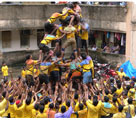 Janmashtami, marks the birth anniversary of Lord Krishna, one of the most popular Hindu Gods. The epicenter of the festival is Vrindavan and Mathura, the birthplace of Lord Krishna. However, the Janmashtami euphoria spreads all across India. Festivities include various rituals being performed by followers. Temples all over India engage in various ceremonies and prayers in honour of Lord Krishna. The festival is celebrated all across the country with the chanting of shlokas, readings from religious texts, singing devotional songs and a number of dance and drama performances depicting the life of Lord Krishna.
Janmashtami, marks the birth anniversary of Lord Krishna, one of the most popular Hindu Gods. The epicenter of the festival is Vrindavan and Mathura, the birthplace of Lord Krishna. However, the Janmashtami euphoria spreads all across India. Festivities include various rituals being performed by followers. Temples all over India engage in various ceremonies and prayers in honour of Lord Krishna. The festival is celebrated all across the country with the chanting of shlokas, readings from religious texts, singing devotional songs and a number of dance and drama performances depicting the life of Lord Krishna.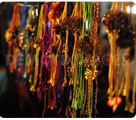 The Teej is a much anticipated monsoon festival for women. It commemorates the reunion of Lord Shiva and Goddess Parvati. Women apply henna to their hands and feet, get dressed up, and parade around. Artists such as folk singers and dancers follow the procession. Caparisoned elephants, bullock carts, and chariots add to the delightful spectacle.
The Teej is a much anticipated monsoon festival for women. It commemorates the reunion of Lord Shiva and Goddess Parvati. Women apply henna to their hands and feet, get dressed up, and parade around. Artists such as folk singers and dancers follow the procession. Caparisoned elephants, bullock carts, and chariots add to the delightful spectacle.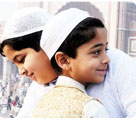 Eid ul Fitr or the 'festival of fast breaking' is the most celebratory of all Muslim festivals. The festival is significant as much for its timing, as for its religious implications. It is celebrated after the long fasting month of Ramadan (the ninth month of the Islamic calendar). The festival of Eid ul Fitr marks the beginning of celebrations for a period extending over three days. Women prepare sweets at home and all Muslims are seen adorned with new dresses on this day. Eid ul Fitr is synonymous with joy and thanksgiving. Such is the spirit of this great festival that even a lot of Non-Muslims participate in Eid celebrations in India.
Eid ul Fitr or the 'festival of fast breaking' is the most celebratory of all Muslim festivals. The festival is significant as much for its timing, as for its religious implications. It is celebrated after the long fasting month of Ramadan (the ninth month of the Islamic calendar). The festival of Eid ul Fitr marks the beginning of celebrations for a period extending over three days. Women prepare sweets at home and all Muslims are seen adorned with new dresses on this day. Eid ul Fitr is synonymous with joy and thanksgiving. Such is the spirit of this great festival that even a lot of Non-Muslims participate in Eid celebrations in India.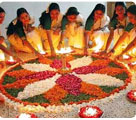 Onam is the biggest festival celebrated in the South Indian state of Kerala. Onam Festival falls during the Malayali month of Chingam (Aug - Sep) and marks the homecoming of legendary King Mahabali. Carnival of Onam lasts for ten days and brings out the best of Kerala culture and tradition. Intricately decorated ‘Pookalam’ floral decorations on the ground; elaborate grand meals called ‘Onasadya’; ‘Vallamkali’ fascinating boat races; decorated elephant processions and exotic dances are some of the most remarkable features of Onam - the harvest festival in Kerala. The beauty of the festival lies in it's secular fabric - people of all religions, castes and communities celebrate Onam, spreading the message of peace and brotherhood.
Onam is the biggest festival celebrated in the South Indian state of Kerala. Onam Festival falls during the Malayali month of Chingam (Aug - Sep) and marks the homecoming of legendary King Mahabali. Carnival of Onam lasts for ten days and brings out the best of Kerala culture and tradition. Intricately decorated ‘Pookalam’ floral decorations on the ground; elaborate grand meals called ‘Onasadya’; ‘Vallamkali’ fascinating boat races; decorated elephant processions and exotic dances are some of the most remarkable features of Onam - the harvest festival in Kerala. The beauty of the festival lies in it's secular fabric - people of all religions, castes and communities celebrate Onam, spreading the message of peace and brotherhood.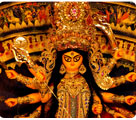 Durga Puja, the most important festival of Bengalis signifies the worship of 'Shakti' or the devine power. It is celebrated throughout India, but more so in the state of West Bengal, with Kolkata being the central hub of celebrations. Durga Puja commemorates the victory of Goddess Durga over the demon Mahishasura. Temples are lit up with thousands of lights, earthen lamps and candles and carnivals are held to celebrate the festival and spread the joy. Singing, dancing, drama performances along with rich Indian delicacies and sweets mark the celebrations of Durga Puja.
Durga Puja, the most important festival of Bengalis signifies the worship of 'Shakti' or the devine power. It is celebrated throughout India, but more so in the state of West Bengal, with Kolkata being the central hub of celebrations. Durga Puja commemorates the victory of Goddess Durga over the demon Mahishasura. Temples are lit up with thousands of lights, earthen lamps and candles and carnivals are held to celebrate the festival and spread the joy. Singing, dancing, drama performances along with rich Indian delicacies and sweets mark the celebrations of Durga Puja.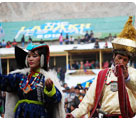 Ladakh festival takes place annually from 01 - 15 September every year in Leh and the villages of Ladakh. The festival highlights the sports and culture of the region. It has plenty to offer tourists, including polo-match, music concerts, mask dances from the monasteries, motorbike / cycle expedition to Khardung-la, Thanka painting exhibition, archery, river rafting, and folk songs. A delightful cultural experience to enjoy in the Himalayas!
Ladakh festival takes place annually from 01 - 15 September every year in Leh and the villages of Ladakh. The festival highlights the sports and culture of the region. It has plenty to offer tourists, including polo-match, music concerts, mask dances from the monasteries, motorbike / cycle expedition to Khardung-la, Thanka painting exhibition, archery, river rafting, and folk songs. A delightful cultural experience to enjoy in the Himalayas!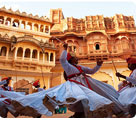 The Marwar Festival is celebrated in the blue hued city of Jodhpur, in Rajasthan. A two day long event, the festival takes place during the full moon. The Marwar Festival is mainly dedicated to the folk heroes of Rajasthan.
The Marwar Festival is celebrated in the blue hued city of Jodhpur, in Rajasthan. A two day long event, the festival takes place during the full moon. The Marwar Festival is mainly dedicated to the folk heroes of Rajasthan. 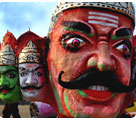 The festival of Dussehra is an important celebration in many parts of India. It is celebrated with great fanfare in most parts of North India, some parts of south India, and in the form of Durga Puja in West Bengal. Dussehra is a popular Hindu festival, which marks the defeat of Ravana by Lord Rama. Dussehra also symbolises the triumph of warrior Goddess Durga over the buffalo demon, Mahishasura. To mark the victory of Lord Rama over Ravana and celebrate the joy, paper statues of Ravana are set on fire on Dussehra day, followed by carnivals held in the cities and suburbs. Celebrations are in the form of religious ceremonies, followed by carnival entertainment with rides and games, music, dance and drama performances, grand feasts and a lot of Indian sweets.
The festival of Dussehra is an important celebration in many parts of India. It is celebrated with great fanfare in most parts of North India, some parts of south India, and in the form of Durga Puja in West Bengal. Dussehra is a popular Hindu festival, which marks the defeat of Ravana by Lord Rama. Dussehra also symbolises the triumph of warrior Goddess Durga over the buffalo demon, Mahishasura. To mark the victory of Lord Rama over Ravana and celebrate the joy, paper statues of Ravana are set on fire on Dussehra day, followed by carnivals held in the cities and suburbs. Celebrations are in the form of religious ceremonies, followed by carnival entertainment with rides and games, music, dance and drama performances, grand feasts and a lot of Indian sweets. One of the most popular Hindu festivals, ‘Deepawali’ or ‘Diwali’, is celebrated to mark the homecoming of Lord Rama from exile. Also called the 'Festival of Lights', Diwali is symbolized by people lighting up their houses, shops, offices with lights, earthen lamps and candles. Lakshmi Puja is performed in the evening to seek divine blessings of Lakshmi, Goddess of Wealth. After the religious puja ceremony, friends and family share a grand feast and sweets, followed by a splendid display of fireworks on almost every street of the country. Diwali gifts are exchanged amongst all near and dear ones.
One of the most popular Hindu festivals, ‘Deepawali’ or ‘Diwali’, is celebrated to mark the homecoming of Lord Rama from exile. Also called the 'Festival of Lights', Diwali is symbolized by people lighting up their houses, shops, offices with lights, earthen lamps and candles. Lakshmi Puja is performed in the evening to seek divine blessings of Lakshmi, Goddess of Wealth. After the religious puja ceremony, friends and family share a grand feast and sweets, followed by a splendid display of fireworks on almost every street of the country. Diwali gifts are exchanged amongst all near and dear ones.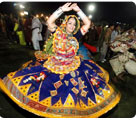 Navaratri is a nine day festival that celebrates the Mother Goddess in all her manifestations. Worship and fasting take place in the daytime, while the nights are reserved for feasting and dancing. The festival culminates with Dussehra, the victory of good over evil, on the tenth day.
Navaratri is a nine day festival that celebrates the Mother Goddess in all her manifestations. Worship and fasting take place in the daytime, while the nights are reserved for feasting and dancing. The festival culminates with Dussehra, the victory of good over evil, on the tenth day.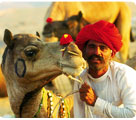 Pushkar festival, held every year in the month of October / November in Rajasthan, is world famous for its camel trading, cattle auctions and camel races along with traditional activities like folk music and dances, colourful village shops and eateries serving traditional delicacies.
Pushkar festival, held every year in the month of October / November in Rajasthan, is world famous for its camel trading, cattle auctions and camel races along with traditional activities like folk music and dances, colourful village shops and eateries serving traditional delicacies.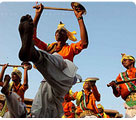 The Hampi Festival is celebrated in the deserted city of Hampi (in Karnataka), once the capital of the historic Vijayanagar Empire. Every year, the city of ruins, Hampi, plays host to a festival of dance and music, known as the Hampi Festival or Vijaya Utsav of Karnataka. The Hampi Dance and Music Festival attracts some of the most distinguished artists from the field of art, dance, music and drama. Splendid performances by reputed artists, against the backdrop of the ancient city of Hampi, is a fascinating experience. Other attractions of the festival include magnificent fireworks, puppet shows and elaborate processions, bringing back to life memories of the bygone era.
The Hampi Festival is celebrated in the deserted city of Hampi (in Karnataka), once the capital of the historic Vijayanagar Empire. Every year, the city of ruins, Hampi, plays host to a festival of dance and music, known as the Hampi Festival or Vijaya Utsav of Karnataka. The Hampi Dance and Music Festival attracts some of the most distinguished artists from the field of art, dance, music and drama. Splendid performances by reputed artists, against the backdrop of the ancient city of Hampi, is a fascinating experience. Other attractions of the festival include magnificent fireworks, puppet shows and elaborate processions, bringing back to life memories of the bygone era.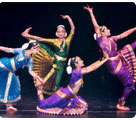 The Ellora Festival is held every year in the Ellora Caves, situated at a distance of approximately 30 km from Aurangabad, in the state of Maharashtra. Ellora festival is a festival of dance and music, showcasing some of the best talents of the region. Some of the most distinguished singers as well as dancers of the country participate in this festival, performing against the backdrop of the structural magnificence of the ancient Ellora caves. This is a unique time to visit Aurangabad and see the city sparkle in the lights and celebrations of the Ellora festival.
The Ellora Festival is held every year in the Ellora Caves, situated at a distance of approximately 30 km from Aurangabad, in the state of Maharashtra. Ellora festival is a festival of dance and music, showcasing some of the best talents of the region. Some of the most distinguished singers as well as dancers of the country participate in this festival, performing against the backdrop of the structural magnificence of the ancient Ellora caves. This is a unique time to visit Aurangabad and see the city sparkle in the lights and celebrations of the Ellora festival.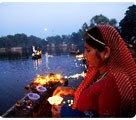 The Kolayat Fair held in Kolayat, Bikaner is also called the 'Kapil Muni Fair'. This fair is observed on the banks of Lake Kolayat. On the day of the festival, devotees take a dip in the lake to wash away their sins. The 52 Ghats along the banks of Lake Kolayat, are lit up to sparkle with festivities. Devotees and pilgrims perform their religious rituals and offer prayers, sugar drops, sweets and milk pudding to the deity. With a serene finale at dusk, several oil lamps are lit and floated on leaves in the calm lake water.
The Kolayat Fair held in Kolayat, Bikaner is also called the 'Kapil Muni Fair'. This fair is observed on the banks of Lake Kolayat. On the day of the festival, devotees take a dip in the lake to wash away their sins. The 52 Ghats along the banks of Lake Kolayat, are lit up to sparkle with festivities. Devotees and pilgrims perform their religious rituals and offer prayers, sugar drops, sweets and milk pudding to the deity. With a serene finale at dusk, several oil lamps are lit and floated on leaves in the calm lake water.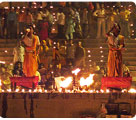 Held along the banks of the holy Ganges River, this unique and mystical festival features cultural programs of classical Indian music and dance. The highlight of the festival is on the last day, when more than a million clay lamps are floated down the holy river Ganges at dusk amidst chanting of Vedic Hindu hymns.
Held along the banks of the holy Ganges River, this unique and mystical festival features cultural programs of classical Indian music and dance. The highlight of the festival is on the last day, when more than a million clay lamps are floated down the holy river Ganges at dusk amidst chanting of Vedic Hindu hymns.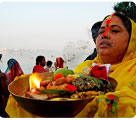 The north Indian festival, traditionally celebrated by the people of Bihar, has grown to be a big occasion in Mumbai as well. Chhat Puja is devoted to worshiping the sun. People flock to the holy river Ganges to offer prayers to the Sun God at sunset. Hymns and folk songs are sung, and women fast and pray for the wellbeing of their family and friends.
The north Indian festival, traditionally celebrated by the people of Bihar, has grown to be a big occasion in Mumbai as well. Chhat Puja is devoted to worshiping the sun. People flock to the holy river Ganges to offer prayers to the Sun God at sunset. Hymns and folk songs are sung, and women fast and pray for the wellbeing of their family and friends. Christmas celebrates the birth of Jesus Christ and conveys his message of love, tolerance and brotherhood. It's a celebration of humanity and mankind. Though Christmas is primary a festival of Christian calendar, it is celebrated as a universal festival through out India. Christmas is the most important festival of Indian Christians, but celebrated with equal joy by non Christians as well. In India, people decorate banana or mango trees instead of traditional pine trees. They also light small oil-burning lamps as Christmas decorations and fill their churches and homes with red flowers. Gifts are exchanged between near and dear ones, prayers are held in the church, followed by a grand feast. Unlike their western counterparts, Indians are not big turkey eaters; so, don’t be surprised to see a grand Christmas feast that is pure vegetarian! Although at most places turkey, chicken, lamb or fish will be served.
Christmas celebrates the birth of Jesus Christ and conveys his message of love, tolerance and brotherhood. It's a celebration of humanity and mankind. Though Christmas is primary a festival of Christian calendar, it is celebrated as a universal festival through out India. Christmas is the most important festival of Indian Christians, but celebrated with equal joy by non Christians as well. In India, people decorate banana or mango trees instead of traditional pine trees. They also light small oil-burning lamps as Christmas decorations and fill their churches and homes with red flowers. Gifts are exchanged between near and dear ones, prayers are held in the church, followed by a grand feast. Unlike their western counterparts, Indians are not big turkey eaters; so, don’t be surprised to see a grand Christmas feast that is pure vegetarian! Although at most places turkey, chicken, lamb or fish will be served.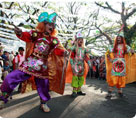 Kochi Carnival is held in the last week of December, in Kochi, every year. Fort Kochi is decorated and tourists flock to this lovely port city to participate in the festivities. Inception of the Kochi carnival can be traced back to the Portuguese New Year revelry, held here during the colonial days.
Kochi Carnival is held in the last week of December, in Kochi, every year. Fort Kochi is decorated and tourists flock to this lovely port city to participate in the festivities. Inception of the Kochi carnival can be traced back to the Portuguese New Year revelry, held here during the colonial days.
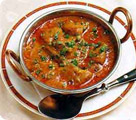 North Indian flavours have become an important part of international cuisine. Beloved for its specialized 'Tandoori' dishes, North Indian cuisine is popular world wide, be it with the Asians, Brits, Americans, Aussies and now even the Kiwis! The conventional Indian Tandoor is now widely used and advocated by the likes of Jamie Oliver and Gordon Ramsay.
North Indian flavours have become an important part of international cuisine. Beloved for its specialized 'Tandoori' dishes, North Indian cuisine is popular world wide, be it with the Asians, Brits, Americans, Aussies and now even the Kiwis! The conventional Indian Tandoor is now widely used and advocated by the likes of Jamie Oliver and Gordon Ramsay.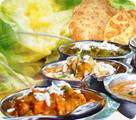 West Indian states of Rajasthan and Gujarat are largely vegetarian, owing to their hot and dry climate. Due to the peculiar climate conditions, vegetables are preserved as pickles and chutneys, so they last longer and can be consumed throughout the year.
West Indian states of Rajasthan and Gujarat are largely vegetarian, owing to their hot and dry climate. Due to the peculiar climate conditions, vegetables are preserved as pickles and chutneys, so they last longer and can be consumed throughout the year.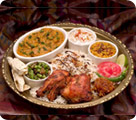 Simple is the key word for food of this region of India. Steaming and frying are popular methods of cooking. In coastal regions fish is the non-vegetarian food of choice. The people of no other region in India can rival the love for sweets and desserts that Eastern Indians have! The geographical location of this region means its food bears the strong influence of Chinese and Mongolian cuisine.
Simple is the key word for food of this region of India. Steaming and frying are popular methods of cooking. In coastal regions fish is the non-vegetarian food of choice. The people of no other region in India can rival the love for sweets and desserts that Eastern Indians have! The geographical location of this region means its food bears the strong influence of Chinese and Mongolian cuisine.
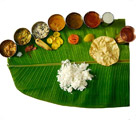 South Indian cuisine is perhaps the hottest of all Indian food. Meals are centered around rice or rice-based dishes and dosa (south Indian crepe made from rice and lentils). Rice and / or dosa is combined with Sambar (a soup-like lentil dish tempered with whole spices and chillies) and rasam (a hot-sour soup like lentil dish), dry and curried vegetables and meat dishes, fish and prawn dishes, and a host of coconut-based chutneys and poppadums (deep-fried crispy lentil pancakes). South Indians are great lovers of dark filter coffee.
South Indian cuisine is perhaps the hottest of all Indian food. Meals are centered around rice or rice-based dishes and dosa (south Indian crepe made from rice and lentils). Rice and / or dosa is combined with Sambar (a soup-like lentil dish tempered with whole spices and chillies) and rasam (a hot-sour soup like lentil dish), dry and curried vegetables and meat dishes, fish and prawn dishes, and a host of coconut-based chutneys and poppadums (deep-fried crispy lentil pancakes). South Indians are great lovers of dark filter coffee.




